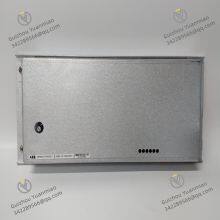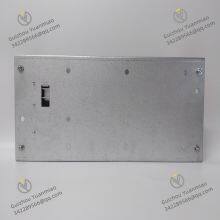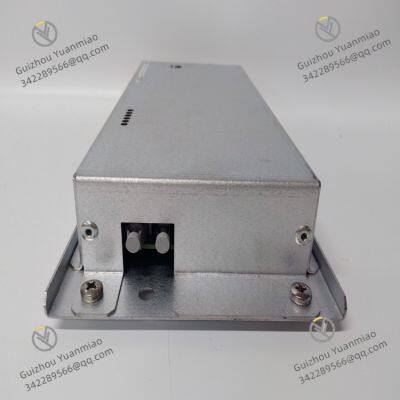Material
Other, Global universal model
Certification
CE
Function
Other, Global universal model
Condition
New
Task
Other, Global universal model
Mathematical Model
Other, Global universal model
Signal
Other, Global universal model
Customized
Non-Customized
Structure
Other, Global universal model
ASE2UDC920AE01 3BHB022793R0001 is the core Digital Input/Output (DI/DO) module of the UDC 920 series process control system developed by ABB Group (Switzerland). It mainly undertakes the functions of collecting and processing digital signals in industrial fields, as well as outputting execution commands. As such, it serves as a key hardware unit for the UDC 920 system to realize "equipment status monitoring, logical control, and safety interlocking".
Designed to meet industrial-grade requirements for high reliability, electromagnetic interference (EMI) resistance, and flexible scalability, this module is widely used in process control scenarios across industries including power, chemical engineering, metallurgy, and oil & gas. Typical applications include reactor temperature interlocking, pump/valve start-stop control, and equipment fault monitoring. Essentially, it acts as a "signal bridge" connecting on-site sensors/actuators to the main control unit of the UDC 920 system.

As the digital interface module of the UDC 920 system, this module is mainly used in "switch signal interaction" scenarios in industrial fields. Typical applications include:
Equipment Status Monitoring: It collects digital signals from on-site sensors (such as the operating status of pumps/fans, open/close feedback of valves, and high/low liquid level signals from liquid level switches), converts the "on/off" status into digital signals recognizable by the system, and transmits them to the UDC 920 main control unit.
Logical Control Execution: It receives control commands from the UDC 920 main control unit, drives the output of relays or contactors, and realizes operations such as pump/valve start-stop, heater on/off, and alarm light activation. For example, when the temperature of a chemical reactor exceeds the standard, it outputs a signal to cut off the heating power supply.
Safety Interlock Protection: It accesses Emergency Shutdown (ESD) signals (such as overpressure switches of pressure transmitters and fault signals of flame detectors). When a dangerous signal is detected, it quickly outputs a shutdown command through the hardware interlock circuit, without delay through the main control unit, to ensure process safety.
Multi-Equipment Collaborative Control: In production line scenarios, it synchronously collects status signals of multiple pieces of equipment (such as conveyor belt operation and silo material level) and outputs collaborative control commands (such as starting the feeding pump when the material level is low, and stopping feeding when the conveyor belt malfunctions).
Key Technical Parameters1. Digital Input (DI) Performance Parameters
| Parameter Category | Specific Specifications |
|---|
| Number of Input Channels | 8 independent DI channels, supporting single-ended or differential input (selected via module jumpers). Electrical isolation between channels (500V AC for 1 minute) to prevent signal interference between channels. |
| Input Signal Type | - Dry contact input: Supports passive contacts (e.g., travel switches, limit switches) with a contact rating of ≤1A/250V AC.
- Wet contact input: Supports active signals (e.g., NPN/PNP sensor outputs) with an input voltage range of DC 24V ±10% (compatible with industrial standard 24V sensors). |
| Input Response Time | Typical value ≤1ms (from signal trigger to module recognition), maximum response time ≤5ms, meeting the needs of rapid status monitoring (e.g., fault detection of high-speed equipment). |
| Input Impedance | Dry contact input: ≥10kΩ; Wet contact input: ≤1kΩ (ensures stable sensor signal input and prevents misjudgment caused by leakage current). |
| Overvoltage/Overcurrent Protection | Each DI channel has a built-in TVS (Transient Voltage Suppressor) diode (rated voltage 36V), capable of withstanding a DC 60V surge voltage (duration ≤100ms); a built-in current-limiting resistor (200Ω) prevents module damage due to overcurrent. |
2. Digital Output (DO) Performance Parameters
| Parameter Category | Specific Specifications |
|---|
| Number of Output Channels | 4 independent DO channels, using relay output (Single-Pole Double-Throw, SPDT). Electrical isolation between channels (1000V AC for 1 minute). |
| Output Contact Rating | - Resistive load: 2A/250V AC or 2A/30V DC
- Inductive load: 0.5A/250V AC or 0.5A/30V DC (external freewheeling diode required)
- Lamp load: 1A/250V AC (compatible with industrial alarm lamps and indicator lamps) |
| Output Response Time | Relay pull-in time ≤10ms, release time ≤5ms, meeting the needs of medium-to-low speed control (e.g., pump/valve start-stop, heater control). |
| Output Protection Function | Each DO channel has a built-in overcurrent protection fuse (2.5A/250V AC), which automatically blows in case of load short circuit to protect the module's output circuit; relay contacts are made of silver alloy to enhance arc resistance and service life. |
3. Electrical and Environmental Parameters
| Parameter Category | Specific Specifications |
|---|
| Power Supply Requirements | - Module power supply: DC 24V ±10% (from UDC 920 system-specific power supply module, e.g., 3BHB013089R0001), ripple ≤100mV
- Power consumption: ≤3W during normal operation (no output load), ≤8W at full-load output (4 channels with 2A load each) |
| Communication Interface | - System bus: Compatible with UDC 920 system-specific backplane bus (PROFIBUS DP slave protocol), maximum communication rate 12Mbps, data update cycle ≤10ms
- Communication connector: 15-pin D-Sub plug (with locking screws), supporting hot swapping (operation required when the system is powered off or in "module offline" state) |
| Environmental Adaptability | - Operating temperature: -25℃ ~ +60℃ (wide-temperature design, suitable for high-temperature workshops and outdoor control cabinet scenarios)
- Relative humidity: 5% ~ 95% RH (no condensation, preventing component corrosion caused by moisture)
- Electromagnetic Compatibility (EMC): Complies with IEC 61000-6-2 industrial standard, withstanding 10V/m radio frequency interference (80MHz-1GHz), 4kV electrostatic discharge (ESD), and 2kV electrical fast transient (EFT) pulses
- Vibration resistance: ≤5g (frequency 10-2000Hz), adapting to vibration environments near pumps and compressors |
| Physical Specifications | - Dimensions (H × W × D): 120mm × 160mm × 80mm (compatible with UDC 920 system standard 3U rack, supporting DIN rail or panel mounting)
- Weight: Approximately 0.5kg (including relays and connectors)
- Indicator lamps: Each DI/DO channel is equipped with an LED status lamp (green = normal, red = fault/triggered); module power lamp (yellow) and communication lamp (blue) for on-site fault diagnosis |

Core Functions and Technical Features1. High-Reliability Digital Signal Processing
Targeting the complex signal environment of industrial sites, the module ensures the stability of signal acquisition and output through hardware design and algorithm optimization:
Channel Electrical Isolation: Optoelectronic isolation technology (isolation voltage: 500V AC) is adopted between DI/DO channels, module power supply, and the system bus. This prevents strong on-site electrical signals (e.g., surge from motor start-stop) from intruding into the system bus and damaging the main control unit.
Signal Debouncing: Software debouncing is applied to the switch signals input via DI channels (debounce time: 1ms–100ms adjustable). For example, when the contacts of a limit switch jitter, the module ignores signal fluctuations shorter than the set debounce time to avoid false triggering of control commands.
Relay Output Protection: The relays of DO channels adopt a "break-before-make" switching logic (SPDT contacts) to prevent two output circuits from being energized simultaneously during load switching. It also supports a "forced output" function (configurable via UDC 920 software), allowing manual forced output of specific states (e.g., emergency opening of safety valves) in case of module failure.
2. Flexible Configuration and Diagnostics CapabilitiesSoftware Configuration Functions
Module parameters can be customized via ABB UDC 920 configuration software (e.g., Control Builder UDC):
DI Channels: Set input type (dry contact/wet contact), debounce time, and signal polarity (high-level active/low-level active).
DO Channels: Set output mode (normally energized/normally de-energized) and fail-safe state (output "on" or "off" when the module is powered off, e.g., closing fuel valves during power outage).
Interlock Logic: Configure direct interlocks between DI and DO channels (e.g., a "high pressure" DI signal triggers a "pump shutdown" DO output). This does not rely on the main control unit, reducing response delay.
Fault Self-Diagnosis
A dual diagnostic mechanism (hardware + software) is built-in:
Hardware Diagnostics: Real-time monitoring of module power voltage (alerts when voltage is below 18V or above 30V), relay contact status (outputs fault signal if contacts stick), and communication bus connection (red fault light illuminates in case of bus interruption).
Software Diagnostics: The UDC 920 main control unit can read module status words (e.g., "channel fault code," "communication error count") and support remote fault reset (no on-site operation required).
Status Indication
The front panel is equipped with 16 LED indicators (8 for DI channels, 4 for DO channels, 2 for power/communication, and 2 for faults). Operators can quickly determine channel status via indicator colors (e.g., steady green for DI channel = signal on; flashing red for DO channel = output fault).
3. Safety Interlock and Redundancy Design
It meets the safety control requirements of industrial scenarios and supports risk prevention for critical links:
Safety Interlock Function: Complies with the IEC 61508 SIL 2 safety standard and can serve as an input/output unit for safety loops (e.g., emergency shutdown loops of chemical plants). DI channels support "dual-channel redundant acquisition" (two channels acquire the same signal, and validity is confirmed only if the two signals match). DO channels support "dual-output drive" (two outputs control the same actuator to ensure reliable execution of commands).
Hot-Swapping Support: In the UDC 920 system’s "module offline" mode, the module can be hot-swapped (a dedicated tool is required). The replacement process does not affect the operation of other modules, reducing system downtime (suitable for continuous production scenarios such as oil refineries and power plants).
Parameter Backup and Restoration: Module configuration parameters are stored in non-volatile memory (EEPROM) and will not be lost after power outage. Parameters can be backed up via UDC 920 software and quickly imported to a new module after replacement, eliminating the need for reconfiguration.















































